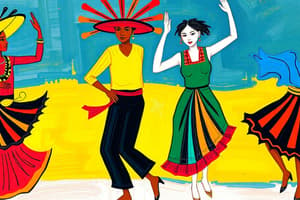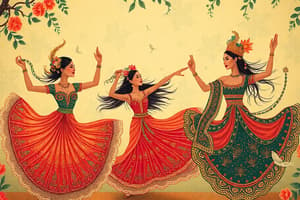Podcast
Questions and Answers
Where did the lively festival dance Jotabal originate?
Where did the lively festival dance Jotabal originate?
- Marikina, Rizal
- Santa Maria, Bulacan
- Lubang Island, Mindoro
- Camohaguin, Gumaca, Quezon (correct)
What is the primary skill required to perform Pandanggo sa llaw effectively?
What is the primary skill required to perform Pandanggo sa llaw effectively?
- Knowledge of historical Spanish dance history
- Excellent balancing skills to maintain stability of lamps (correct)
- Flexibility to perform various dance movements
- The ability to clap in time with the music
Which dance is associated with the musical accompaniment of musicians using bamboo instruments?
Which dance is associated with the musical accompaniment of musicians using bamboo instruments?
- Balse (correct)
- Pandanggo sa llaw
- Makonggo
- Jotabal
What does the term 'Balse' refer to in relation to dance style?
What does the term 'Balse' refer to in relation to dance style?
What characteristic is notable in the Makonggo dance?
What characteristic is notable in the Makonggo dance?
What does the name 'Cariñosa' emphasize in the context of Philippine folk dance?
What does the name 'Cariñosa' emphasize in the context of Philippine folk dance?
What is the primary theme portrayed in the 'Maglalatik' dance?
What is the primary theme portrayed in the 'Maglalatik' dance?
Which dance represents the act of fetching water and showcases the strength of women?
Which dance represents the act of fetching water and showcases the strength of women?
Which characteristic is common to many traditional Philippine folk dances?
Which characteristic is common to many traditional Philippine folk dances?
How do Philippine folk dances reflect their cultural heritage?
How do Philippine folk dances reflect their cultural heritage?
What is the setting often associated with the performance of traditional Philippine folk dances?
What is the setting often associated with the performance of traditional Philippine folk dances?
In the performance of 'Cariñosa', how do dancers typically interact?
In the performance of 'Cariñosa', how do dancers typically interact?
What purpose do many folk dances serve in the context of Philippine culture?
What purpose do many folk dances serve in the context of Philippine culture?
Flashcards are hidden until you start studying
Study Notes
Philippine Folk Dance Overview
- Reflects diverse influences from immigrants and conquerors, showcasing the rich culture of the Philippines.
- Developed during agricultural work and celebrations, embodying rituals, feasts, and life events like births and weddings.
- Represents various themes, including nature, courtship, and seasonal events, with many sub-genres present.
Tradition and Evolution
- Folk dances have evolved over generations, retaining core characteristics despite regional variations.
- Many dances originated as a way to honor gods for natural and agricultural blessings, such as rain, harvests, and military victories.
- Modern celebrations still include these traditional dances, often performed in costumes from tribal times.
Popular Folk Dances
- Cariñosa: An affectionate dance characterized by flirtatious movements using fans or handkerchiefs, symbolizing courtship between sweethearts.
- Banga: A contemporary Kalinga dance showcasing women carrying heavy clay pots to fetch water, illustrating their grace and strength.
- Maglalatik: A mock war dance representing a fight over prized coconut meat, featuring rhythmic slapping of coconut shells in a four-part performance.
- Pandanggo sa Llaw: Originating from Lubang Island, Mindoro, this dance involves balancing oil lamps while performing lively steps and clapping in ¾ beat.
- Balse: A dance akin to the waltz, popular in Marikina, Rizal, performed post-religious processions with bamboo instruments.
- Jotabal: A lively festival dance combining Spanish influences, derived from Jota and valse, originating in Camohaguin, Gumaca, Quezon.
- Makonggo: A comic dance from Santa Maria, Bulacan, where a male dancer imitates a monkey's playful gestures and improvisations.
Cultural Significance
- Folk dances continue to be integral in celebrating cultural identity and heritage, connecting modern Filipinos to their ancestral roots through performance and tradition.
Studying That Suits You
Use AI to generate personalized quizzes and flashcards to suit your learning preferences.




